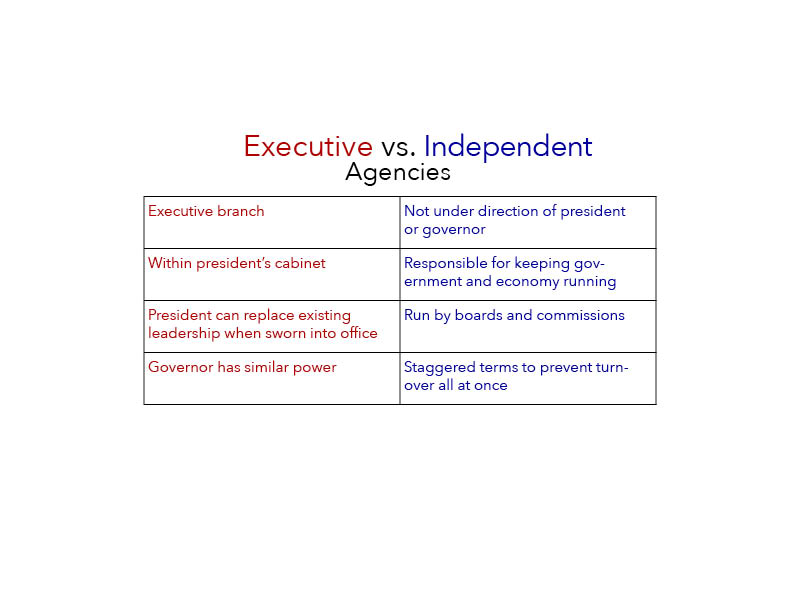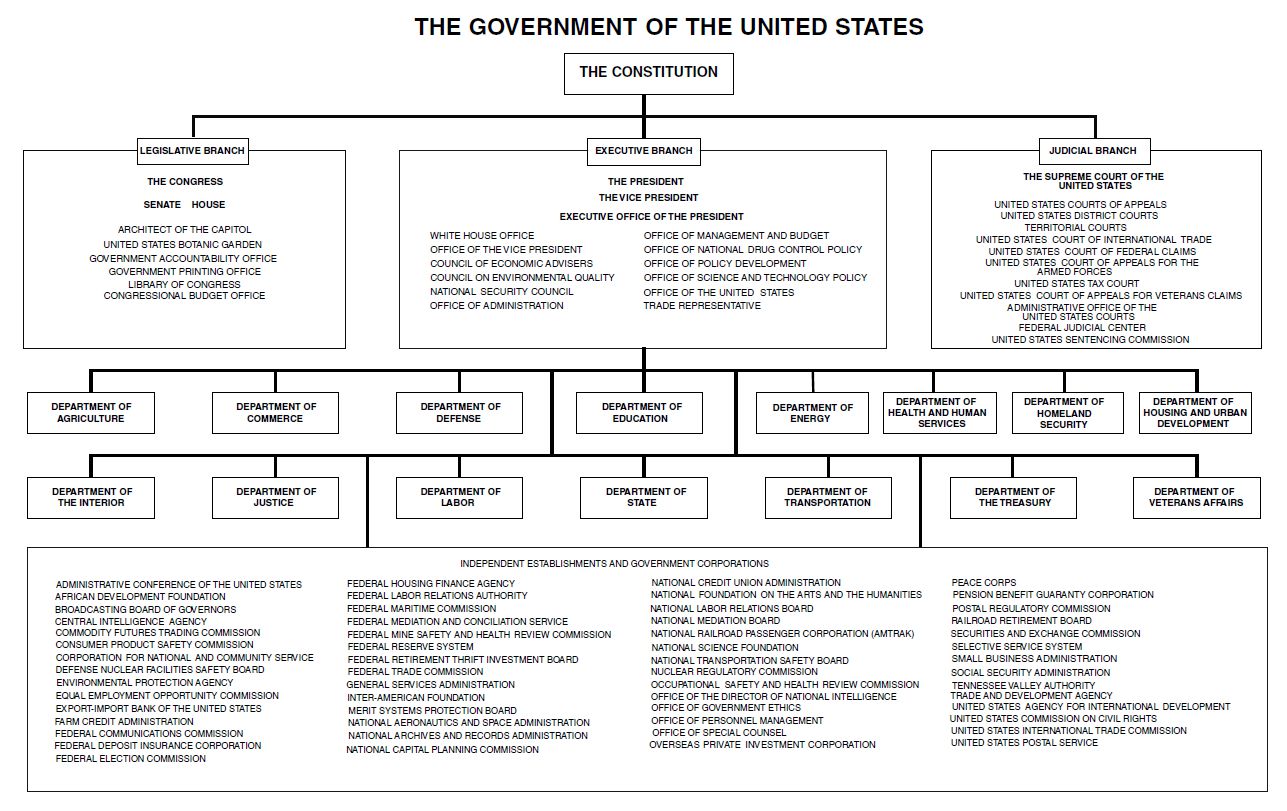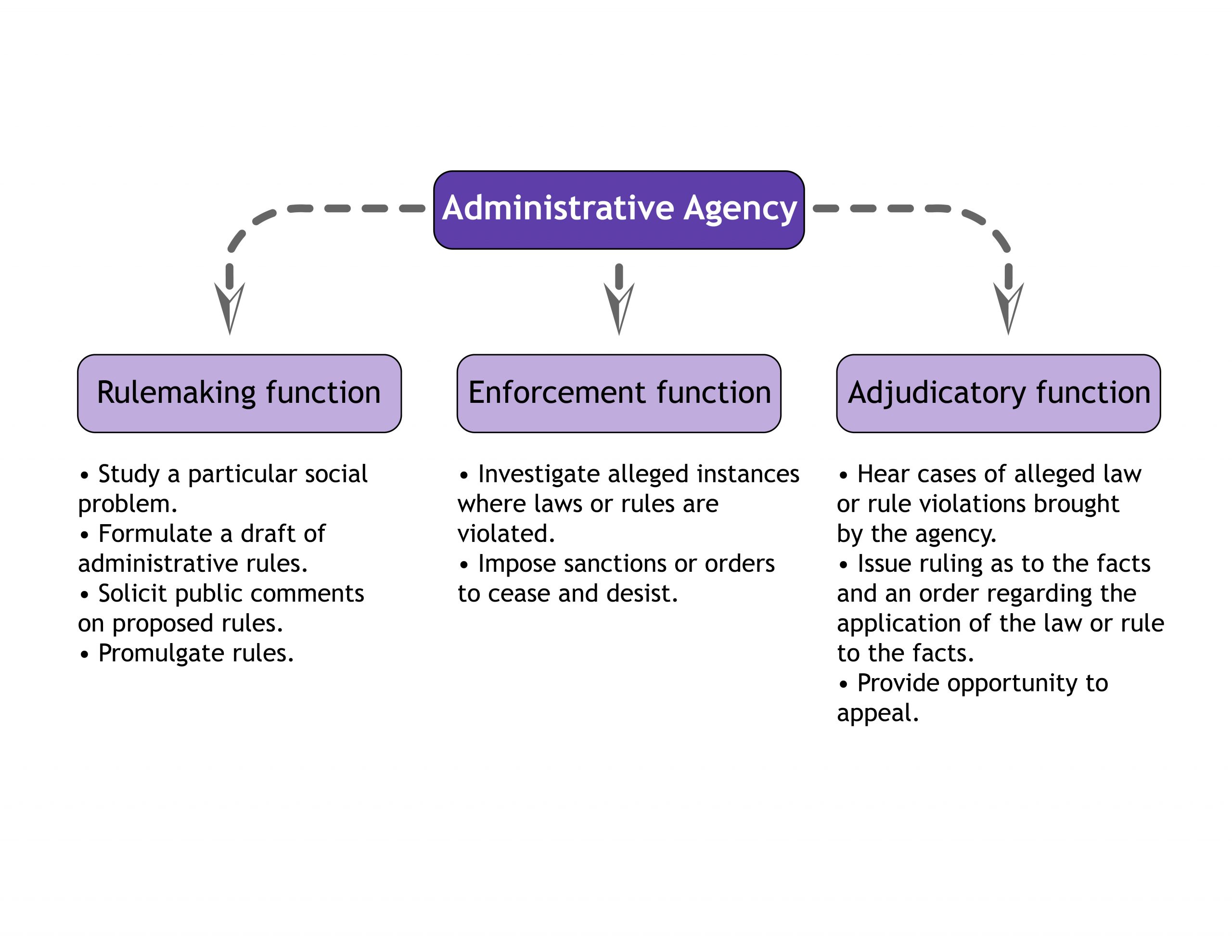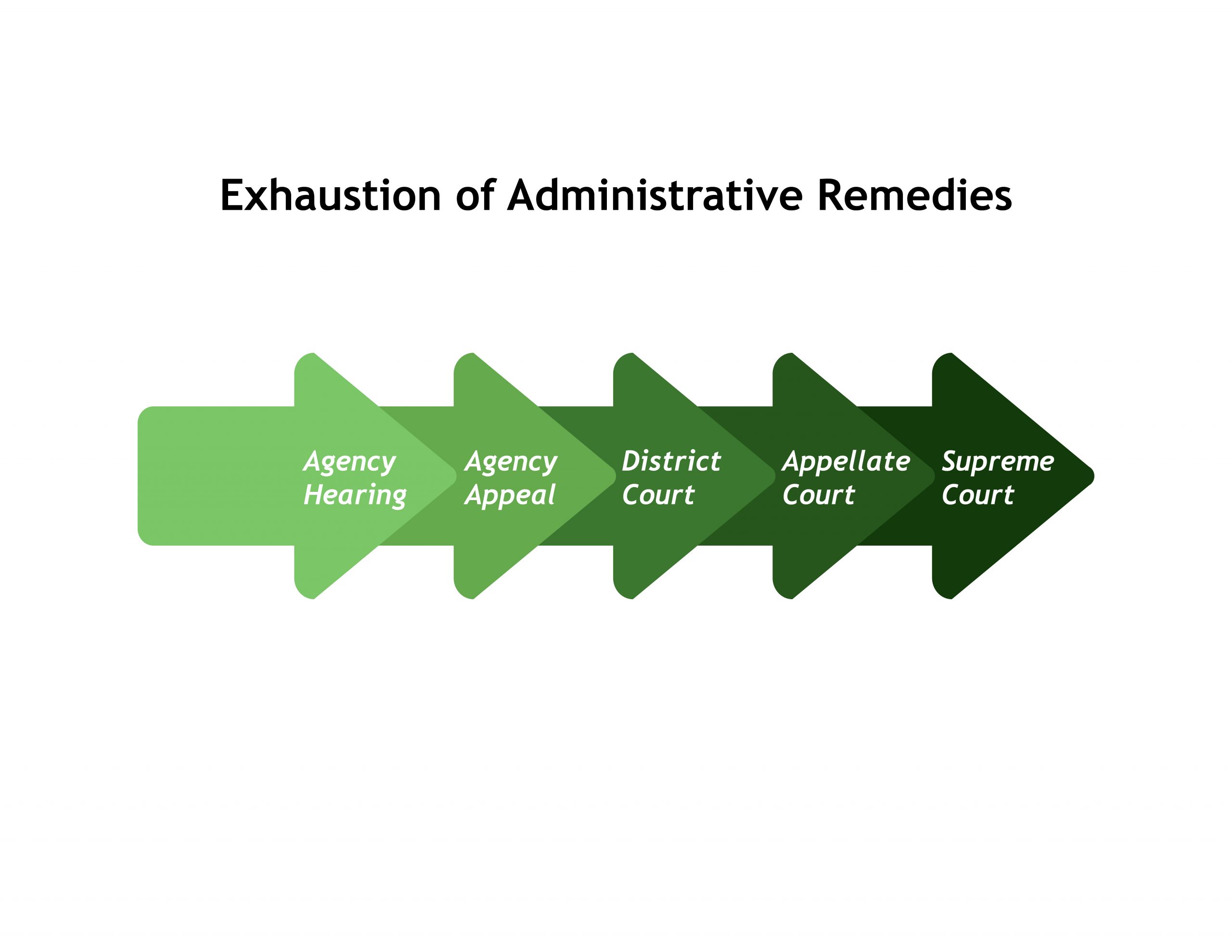7
7.1 Introduction
LEARNING OBJECTIVES
- Understand the roles and functions of administrative agencies.
- Explore judicial review of agency actions.
- Learn how administrative agencies impact the daily operation of businesses.
An administrative agency is a governmental body with the authority to implement and administer particular legislation. They also are called government agencies or regulatory agencies.
The day-to-day operations of businesses across industries are shaped primarily by the actions of administrative agencies. This is because Congress and state legislatures often create agencies to regulate and enforce important legislation. Agencies exist at all levels of government and have considerable power to achieve their regulatory objectives.
7.2 Creation of Administrative Agencies
Administrative agencies are created by Congress or state legislatures through an enabling act. An enabling act is a statute that creates an administrative agency and determines the scope of power granted to that agency. Some enabling acts are quite general and grant the agency a lot of discretion. Other enabling acts are more limited and identify the specific type of power an agency has.
While the legislative branch creates administrative agencies, they are usually part of the executive branch because their primary purpose is to enforce the law. Agencies in the executive branch are called executive agencies. At the federal level, these agencies are within the president’s cabinet. The president is granted the power to appoint and oversee the leadership of executive agencies, including replacing existing leadership when the president is sworn into office. A governor has similar power over executive agencies at the state level.
An independent agency is an agency, commission, or board that is not under the direction of the president or governor. Congress and and state legislatures create independent agencies when they want to insulate the work of the agencies from politics and to address concerns that go beyond the scope of ordinary legislation. These agencies are responsible for keeping the government and economy running smoothly, especially when different political parties come to power. Examples of independent agencies include the Federal Trade Commission and the Central Intelligence Agency.
Independent agencies are often run by boards or commissions made up of five to seven members, who are from both major political parties, as well as political independents or smaller political parties. The term of board members and commissioners is usually four to nine years, with terms being staggered to prevent complete turnover all at once.
Figure 7.1 Differences Between Executive and Independent Agencies

Congress passed the Administrative Procedures Act (APA) to ensure the rights of businesses and individuals are protected when interacting with federal agencies. The APA is a very complex statute that controls all aspects of agency activity to guarantee uniformity and fairness across agencies. For example, the APA establishes the mechanisms for rulemaking, conducting adjudications, and giving notice to the public. The APA also establishes the process for judicial review of agency decisions. Most states have similar statutes to regulate state and local agencies.
Figure 7.2 Organizational Chart of Federal Agencies

7.3 Agency Functions
Administrative agencies carry out their purpose through the exercise of power in three ways that mirror the three branches of government:
- Agencies engage in rulemaking, which is a quasi-legislative function;
- Agencies engage in enforcement, which is a quasi-executive function; and
- Agencies engage in adjudication, which is a quasi-judicial function.
Figure 7.3 Roles and Responsibilities of Administrative Agencies

Rulemaking
The enabling statute dictates the types of rules an agency can make to implement and enforce the legislation for which it is responsible. Generally, administrative rules are characterized as internal, procedural, interpretive, and legislative.
| Types of Rulemaking | Description |
| Internal | Policies and procedures adopted for in-house operations |
| Procedural | Policies and procedures related to how the agency functions & interacts with businesses and individuals |
| Interpretive | Guidelines issued by the agency to businesses and individuals about how to comply with the law |
| Legislative | Regulations that have the full force of law because they are an extension of the underlying statute |
Legislative rulemaking may be formal or informal. Formal rulemaking is agency rulemaking that, when required by the enabling statute, must be on the record after an opportunity for an agency hearing, and must comply with certain procedures, such as allowing evidence and the cross-examination of witnesses. Formal rulemaking provides an opportunity to publicly and thoroughly debate the propriety of a suggested rule. However, this process is very expensive and is sometimes subject to political delays.
Informal rulemaking occurs when the agency publishes a proposed regulation and receives public comments on it, after which the regulation can take effect without the necessity of a formal hearing on the record. Informal rulemaking is the most common procedure followed by an agency when issuing substantive rules because it is less expensive and more efficient.
Agencies will sometimes blend the the two types of rulemaking into a hybrid rulemaking approach. This type of rulemaking requires notice and a hearing on a proposed rule but the hearing is not as extensive as in formal rulemaking and cross-examination of witnesses is not available.
Enforcement
Agencies are empowered to enforce administrative rules and the underlying legislation identified in the agency’s enabling act. Unlike law enforcement investigations, agencies do not need probable cause to initiate an investigation. Generally, agencies are authorized to investigate simply to ensure the rules are being followed. For example, the Internal Revenue Service may audit a business’s taxes without any suspicion of wrongdoing.
Agencies are limited in their power to subpoena evidence in the form of testimony from witnesses and in obtaining documents and evidence. To be lawful, an agency’s subpoena must:
- Establish that the purpose of the investigation is legitimate;
- Establish that the agency has the power to conduct the investigation;
- Describe the requested information;
- Explain the relationship between the purpose of the investigation and the requested information; and
- Show that the requested information does not create an unreasonable burden on the business or individual in possession of it.
Businesses do not have all the Constitutional protections as individuals do, especially when it comes to agency investigations. In particular, a business cannot assert a Fifth Amendment right against self-incrimination to prevent agencies from obtaining business records. If an agency subpoenas documents, a business is required to turn them over, even if doing so exposes the business and individuals to potential criminal liability.
Adjudication
Adjudication is the legal process of resolving a dispute. In an agency context, this is the trial-like procedure or hearing used by agencies to enforce their actions and determine whether a business or individual has violated the law or regulations.
Adjudication can be either formal or informal. Formal adjudication is like a trial and is usually overseen by an administrative law judge (ALJ). The ALJ will decide what evidence is relevant and admissible, hear testimony, and determine the outcome of the dispute in a written finding. If appropriate, the ALJ also will determine a penalty.
Like the judiciary, agencies have an internal appeal process for adjudication. If a party wants to appeal a hearing officer or ALJ’s decision, the case will be reviewed internally by the agency. Often, appeals boards will consist of three to five agency experts who review the determination.
7.4 Judicial Review of Agency Actions
The APA provides for judicial review of almost all agency decisions. However, before going to court, a business or individual must try to get the agency to reconsider its action. To this end, two requirements must be satisfied:
- Administrative remedies must be exhausted; and
- The party must have standing.
Exhaustion of administrative remedies is the doctrine that, if an administrative remedy is provided by statute, a party must seek relief first from the agency before judicial relief is available. The purpose of this doctrine is to ensure that courts will not be burdened by cases in which judicial relief is unnecessary. Often courts cite the agency’s subject matter expertise as a reason to allow it to reconsider its action and fix errors, especially common ones that may impact more than just the party involved in the hearing.
Figure 7.4 Exhaustion of Administrative Remedies Flowchart

Standing is the requirement that only individuals and entities with a personal stake in the outcome of a controversy may seek judicial review. Standing is discussed more in Chapter 3. With respect to agency actions, this is often a litigated issue when advocacy groups want to challenge an agency’s decision but were not a party to the agency’s actions.
Because agencies have significant discretion in regulating their areas of expertise, judicial review of agency actions is limited. A court will review an agency’s actions in five situations:
| Basis for Judicial Review | Description |
| Agency exceeded its authority | Agency acted beyond the authority given to it in the enabling act |
| Agency incorrectly interpreted the law | Agency misunderstands or misapplies the law; courts are the legal experts |
| Agency made a procedural error | Agency failed to follow the APA or its own procedural rules |
| Agency violated the Constitution | Agency violated the Constitutional rights of businesses or individuals |
| Agency made arbitrary or capricious decision | Agency’s decision is neither based on the facts nor grounded in the law |
7.5 Public Access to Agency Information
Accountability and transparency are concerns when governmental entities have a lot of discretion and limited judicial oversight. To ensure that the government remains responsive to the people as required by the Constitution, Congress has passed a series of laws to protect the rights of businesses and individuals.
The Freedom of Information Act (FOIA) was passed by Congress in 1966 to give a mechanism for private citizens to request information from the federal government. The central purpose of FOIA is to open up the workings of government to public scrutiny to keep the government accountable to the people and electorate.
The process is simple. A business or individual sends a letter to the head of an agency requesting information regarding a particular subject. The agency then has ten days to respond. If the agency denies the request, the party may either appeal the decision within the agency or sue in federal court for the information.
Not all information is subject to disclosure under FOIA. FOIA has nine exceptions:
- National security and foreign policy;
- Internal personnel rules and practices of an agency;
- Information that Congress prohibits the disclosure of;
- Trade secrets and confidential commercial or financial information;
- Documents protected by the attorney-client privilege;
- Personnel and medical files that would constitute an unwarranted invasion of personal privacy;
- Some law enforcement information;
- Documents related to the regulation of financial institutions; and
- Geological and geophysical information and data, including well maps.
The media makes about ten percent of FOIA requests, which is part of investigative reporting. However, most requests come from businesses, attorneys, and individuals. Unless an exception applies, the government must disclose the requested information. This has become a tool for businesses seeking advantage over their competition.
For example, AT&T received a federal grant to promote communications in school. AT&T self-reported to the Federal Communications Commission (FCC) that it may have overcharged the government for its services. This resulted in an investigation into AT&T’s services and billing practices. Several months after AT&T and the FCC reached a settlement in which AT&T reimbursed the FCC $500,000, a trade association representing some of AT&T’s competitors made a FOIA request to the FCC for documents related to the investigation and settlement. AT&T tried to block the request, arguing that it was an unwarranted invasion of personal privacy. In a unanimous decision, the US Supreme Court held that corporations do not have a personal privacy right like individuals do. As a result, the FCC disclosed the information to AT&T’s competitors.
Over the years, FOIA has been amended and supplemented through complementary legislation. Businesses and individuals have the right to correct information that was submitted to an agency, as well as the right to specific reasons regarding any information that is withheld or redacted under FOIA. In addition, many agency meetings must be open to the public.
Most states have passed legislation similar to FOIA requiring state and local governments to disclose information to the public.
7.6 Concluding Thoughts
The vast majority of governmental work is done through administrative agencies. Given their functions, they are often referred to as the “Fourth Branch” of government. Agencies exist at all levels of government and have a lot of discretion in implementing and enforcing laws. Most businesses and individuals have contact with the government through agencies so it is incredibly important to understand how they work to be successful in business and avoid legal consequences.
